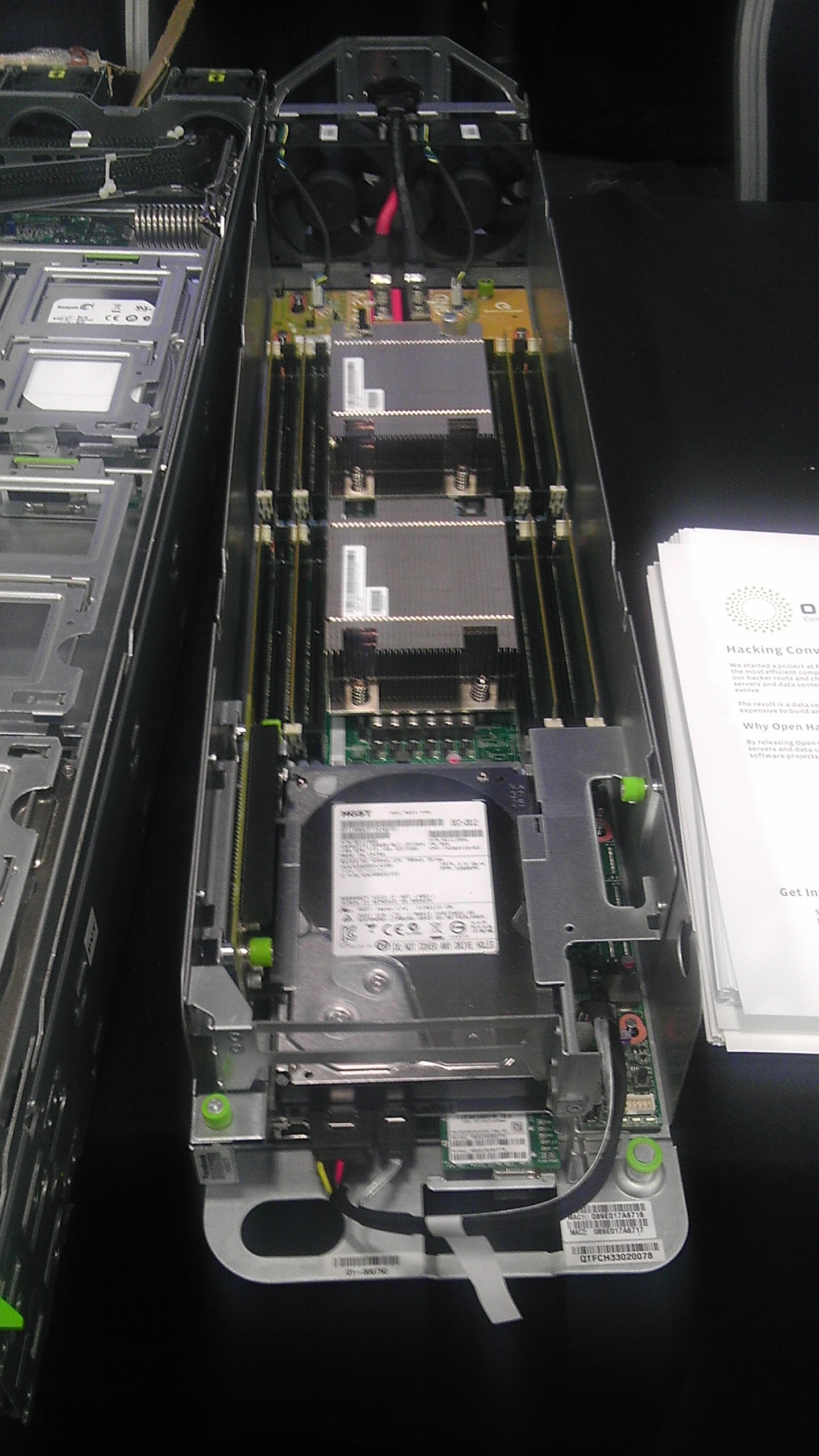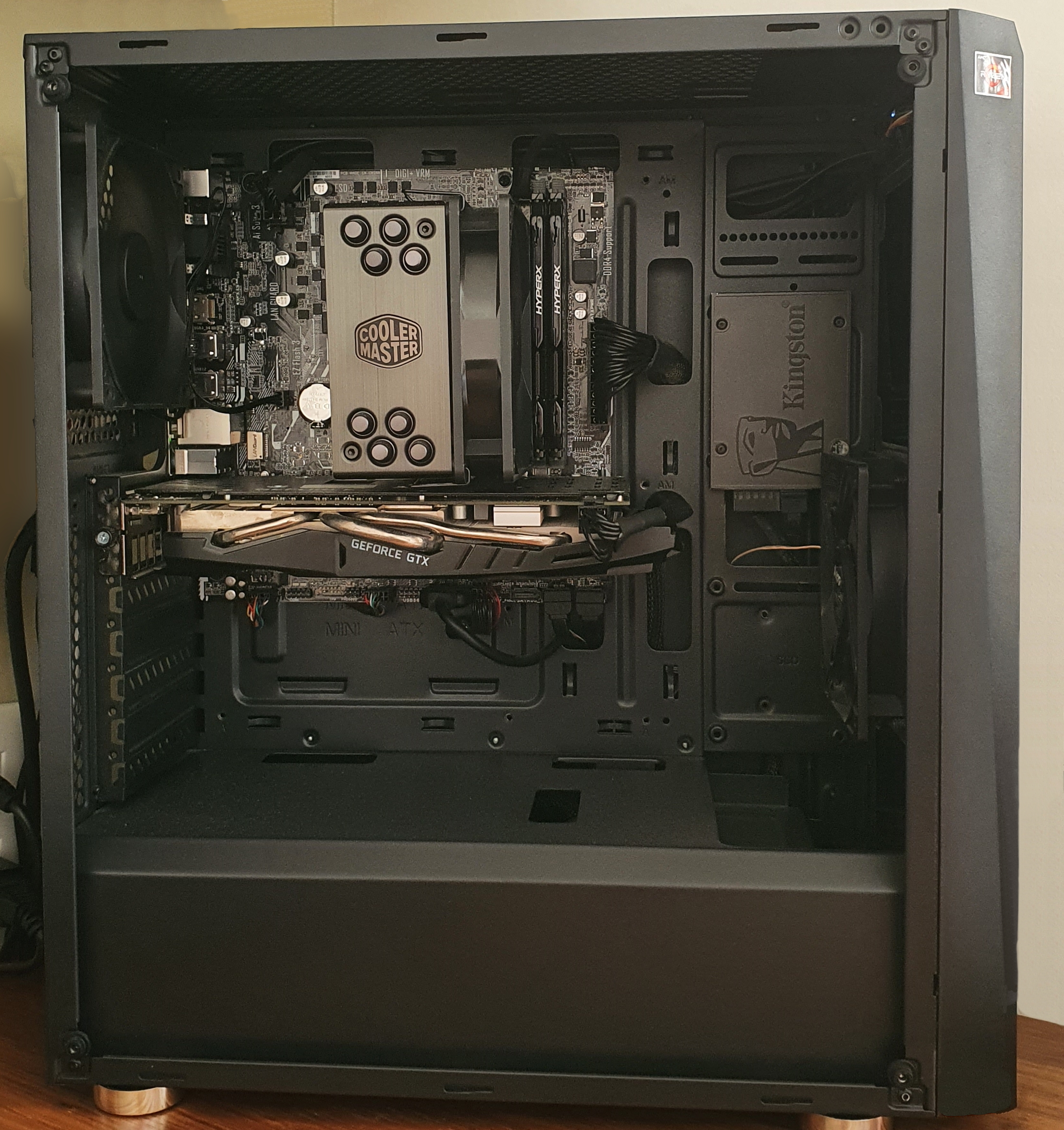|
Open Rack
Open Rack is an Open Compute Project standard for a new rack and power delivery architecture and an efficient, scalable alternative to thEIA-310 rack It differs from the traditional EIA-310 19" rack in that it was designed specifically for large scale cloud deployments. There are four key features that make this rack design more efficient to deploy, support, and operate. The power to all of the compute, storage, or network devices is supplied by a pair of bus bars located in the rear of the rack. The bus bars are supplied with 48V DC by a shelf of power supplies A power supply is an electrical device that supplies electric power to an electrical load. The main purpose of a power supply is to convert electric current from a source to the correct voltage, current, and frequency to power the load. As a res ... which provides efficient conversion from the local (usually 3-phase) AC mains supply. The IT equipment that fits into Open Rack is 21" or 538mm wide. This is a 15% increase ... [...More Info...] [...Related Items...] OR: [Wikipedia] [Google] [Baidu] |
Open Compute Project
The Open Compute Project (OCP) is an organization that shares designs of data center products and best practices among companies, including ARM, Meta, IBM, Wiwynn, Intel, Nokia, Google, Microsoft, Seagate Technology, Dell, Rackspace, Hewlett Packard Enterprise, NVIDIA, Cisco, Goldman Sachs, Fidelity, Lenovo and Alibaba Group. Project structure The Open Compute Project Foundation is a 501(c)(6) non-profit incorporated in the state of Delaware. Rocky Bullock serves as the Foundation's CEO and has a seat on the board of directors. As of July 2020, there are 7 members who serve on the board of directors which is made up of one individual member and six organizational members. Mark Roenigk (Facebook) is the Foundation's president and chairman. Andy Bechtolsheim is the individual member. In addition to Mark Roenigk who represents Facebook, other organizations on the Open Compute board of directors include Intel (Rebecca Weekly), Microsoft (Kushagra Vaid), Google (Partha ... [...More Info...] [...Related Items...] OR: [Wikipedia] [Google] [Baidu] |
19-inch Rack
A 19-inch rack is a standardized frame or enclosure for mounting multiple electronic equipment modules. Each module has a front panel that is wide. The 19 inch dimension includes the edges or "ears" that protrude from each side of the equipment, allowing the module to be fastened to the rack frame with screws or bolts. Common uses include computer servers, telecommunications equipment and networking hardware, audiovisual production gear, and scientific equipment. Overview and history Equipment designed to be placed in a rack is typically described as rack-mount, rack-mount instrument, a rack-mounted system, a rack-mount chassis, subrack, rack cabinet, rack-mountable, or occasionally simply shelf. The height of the electronic modules is also standardized as multiples of or one rack unit or U (less commonly RU). The industry-standard rack cabinet is 42U tall; however, 45U racks are also common. The term ''relay rack'' appeared first in the world of telephony. By 1911, ... [...More Info...] [...Related Items...] OR: [Wikipedia] [Google] [Baidu] |
Cloud Computing
Cloud computing is the on-demand availability of computer system resources, especially data storage ( cloud storage) and computing power, without direct active management by the user. Large clouds often have functions distributed over multiple locations, each of which is a data center. Cloud computing relies on sharing of resources to achieve coherence and typically uses a "pay as you go" model, which can help in reducing capital expenses but may also lead to unexpected operating expenses for users. Value proposition Advocates of public and hybrid clouds claim that cloud computing allows companies to avoid or minimize up-front IT infrastructure costs. Proponents also claim that cloud computing allows enterprises to get their applications up and running faster, with improved manageability and less maintenance, and that it enables IT teams to more rapidly adjust resources to meet fluctuating and unpredictable demand, providing burst computing capability: high comput ... [...More Info...] [...Related Items...] OR: [Wikipedia] [Google] [Baidu] |
Busbar
In electric power distribution, a busbar (also bus bar) is a metallic strip or bar, typically housed inside switchgear, panel boards, and busway enclosures for local high current power distribution. They are also used to connect high voltage equipment at electrical switchyards, and low voltage equipment in battery banks. They are generally uninsulated, and have sufficient stiffness to be supported in air by insulated pillars. These features allow sufficient cooling of the conductors, and the ability to tap in at various points without creating a new joint. Design and placement The busbar's material composition and cross-sectional size determine the maximum current it can safely carry. Busbars can have a cross-sectional area of as little as , but electrical substations may use metal tubes in diameter () or more as busbars. Aluminium smelters use very large busbars to carry tens of thousands of amperes to the electrochemical cells that produce aluminium from molten salts ... [...More Info...] [...Related Items...] OR: [Wikipedia] [Google] [Baidu] |
Switched-mode Power Supply
A switched-mode power supply (switching-mode power supply, switch-mode power supply, switched power supply, SMPS, or switcher) is an electronic power supply that incorporates a switching regulator to convert electrical power efficiently. Like other power supplies, an SMPS transfers power from a DC or AC source (often mains power, see AC adapter) to DC loads, such as a personal computer, while converting voltage and current characteristics. Unlike a linear power supply, the pass transistor of a switching-mode supply continually switches between low- dissipation, full-on and full-off states, and spends very little time in the high dissipation transitions, which minimizes wasted energy. A hypothetical ideal switched-mode power supply dissipates no power. Voltage regulation is achieved by varying the ratio of on-to-off time (also known as duty cycles). In contrast, a linear power supply regulates the output voltage by continually dissipating power in the pass transistor. The ... [...More Info...] [...Related Items...] OR: [Wikipedia] [Google] [Baidu] |
Hot Swapping
Hot swapping is the replacement or addition of components to a computer system without stopping, shutting down, or rebooting the system; hot plugging describes the addition of components only. Components which have such functionality are said to be ''hot-swappable'' or ''hot-pluggable''; likewise, components which do not are ''cold-swappable'' or ''cold-pluggable''. Most desktop computer hardware, such as CPUs and memory, are only cold-pluggable. However, it is common for mid to high-end servers and mainframes to feature hot-swappable capability for hardware components, such as CPU, memory, PCIe, SATA and SAS drives. An example of hot swapping is the express ability to pull a Universal Serial Bus (USB) peripheral device, such as a thumb drive, external hard disk drive (HDD), mouse, keyboard, or printer out of a computer's USB slot or peripheral hub without ejecting it first. Most smartphones and tablets with tray-loading holders can interchange SIM cards without powe ... [...More Info...] [...Related Items...] OR: [Wikipedia] [Google] [Baidu] |
Server Room
A server room is a room, usually air-conditioned, devoted to the continuous operation of computer servers. An entire building or station devoted to this purpose is a data center. The computers in server rooms are usually headless systems that can be operated remotely via KVM switch or remote administration software, such as Secure Shell, VNC, and remote desktop. Climate is one of the factors that affects the energy consumption and environmental impact of a server room. In areas where climate favours cooling and an abundance of renewable electricity, the environmental effects will be more moderate. Thus, countries with favourable conditions such as Canada, Finland, Sweden, and Switzerland are trying to attract companies to site server rooms there. Design considerations Building a server or computer room requires detailed attention to five main design considerations: Location Computer or server room location is the first consideration, even before considering the layout of ... [...More Info...] [...Related Items...] OR: [Wikipedia] [Google] [Baidu] |
Computer Enclosure
A computer case, also known as a computer chassis, is the enclosure that contains most of the hardware of a personal computer. The components housed inside the case (such as the CPU, motherboard, memory, mass storage devices, power supply unit and various expansion cards) are referred as the ''internal'' hardware, while hardware outside the case (typically cable-linked or plug-and-play devices such as the display, speakers, keyboard, mouse and USB flash drives) are known as ''peripherals''. Conventional computer cases are fully enclosed, with small holes (mostly in the back panel) that allow ventilation and cutout openings that provide access to plugs/sockets (back) and removable media drive bays (front). The structural frame (chassis) of a case is usually constructed from rigid metals such as steel (often SECC — steel, electrogalvanized, cold-rolled, coil) and aluminium alloy, with hardpoints for mounting internal hardware, case fans/ coolers and for organizing cab ... [...More Info...] [...Related Items...] OR: [Wikipedia] [Google] [Baidu] |
Server Hardware
In computing, a server is a piece of computer hardware or software (computer program) that provides functionality for other programs or devices, called " clients". This architecture is called the client–server model. Servers can provide various functionalities, often called "services", such as sharing data or resources among multiple clients, or performing computation for a client. A single server can serve multiple clients, and a single client can use multiple servers. A client process may run on the same device or may connect over a network to a server on a different device. Typical servers are database servers, file servers, mail servers, print servers, web servers, game servers, and application servers. Client–server systems are usually most frequently implemented by (and often identified with) the request–response model: a client sends a request to the server, which performs some action and sends a response back to the client, typically with a result or acknowledgme ... [...More Info...] [...Related Items...] OR: [Wikipedia] [Google] [Baidu] |

.jpg)



